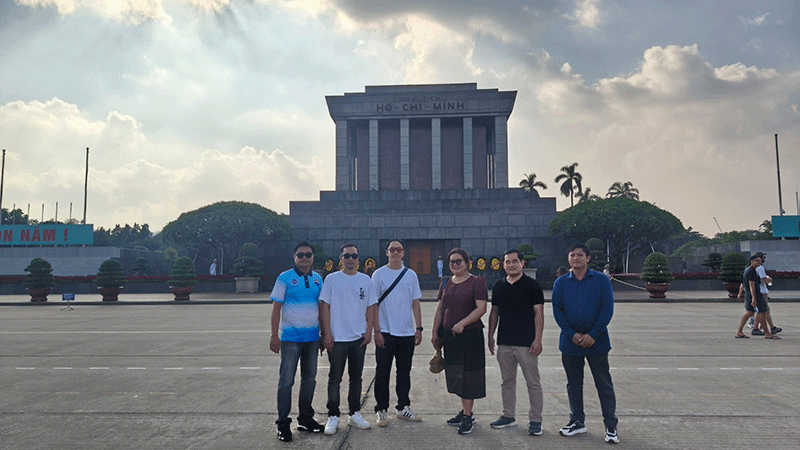 |
Lao media personnel pose for a photo in Hanoi.
|
Vietnam: Where history, culture and noodles come together
Hanoi, the capital of Vietnam, is a city where history, culture, and cuisine blend seamlessly, offering visitors a vibrant experience that reflects the country’s identity and diversity.
In late September, I found myself on a tiny stool in a Hanoi alley, sipping strong Vietnamese coffee from a street stall and watching the city’s rhythm unfold amid the constant honking of motorbikes and the steady stream of people passing by.
The city may be full of tall buildings, but in every corner there seems to be a tea shop, where locals gather over small cups of tea or coffee, chatting on low stools.
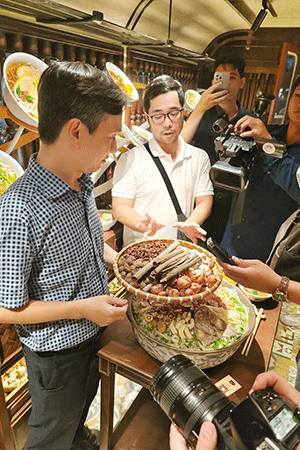 |
Mr Nguyen Dan Huy (left) talks about the ingredients used to make pho soup broth.
|
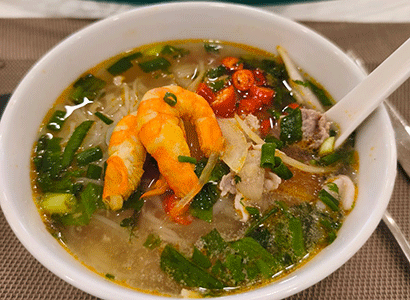 |
A warming dish of shrimp and noodle soup.
|
I was there as part of a Lao media delegation, exploring Vietnam’s culture and cuisine on behalf of the Vientiane Times, together with colleagues from the Lao News Agency, Lao National Radio, Lao National Television, and the Mass Media Department.
The programme, organised by the Authority of Grassroots Information and Foreign Information under Vietnam’s Ministry of Culture, Sports and Tourism, aimed to strengthen cooperation and share experiences between Lao and Vietnamese media professionals, especially in promoting socio-economic development and tourism.
This was my first visit to Hanoi. What made it special was the company of fellow Lao participants and the warm hospitality of our Vietnamese hosts, who guided us through sites, stories, and flavours that made the trip both memorable and fun.
On our second day, we were welcomed by the Vice Chairman of the Ba Dinh Ward People’s Committee, Mr Nguyen Dan Huy, who shared the story of Vietnam’s noodle culture.
Varying types of pho are made in different regions of Vietnam and may include bun cha, mien, and red crab noodles, he explained, saying that each dish reflects local history, ingredients, and traditions. Vietnam, he said, may have the widest variety of noodles in the world.
What struck me most was the freshness of the ingredients, lightly seasoned but full of flavour, often with lime or chilli on the side.
As a pho fan back in Laos, I was curious to try Hanoi’s original version. It turned out to be lighter, more aromatic, and just as delicious in its own way.
To make the experience more interactive, Mr Nguyen hosted a fried spring roll competition and, even though I didn’t win, I had a lot of fun.
Rolling and cooking our own spring rolls and then enjoying them together was certainly a highlight of the trip.
Although Vietnamese food is familiar to people in Laos, making spring rolls on home ground, with their slightly different herbs, sauces, and flavours, was an unforgettable experience. The crispy rolls, wrapped in lettuce and herbs and dipped in tangy sauce, were simple yet extraordinary.
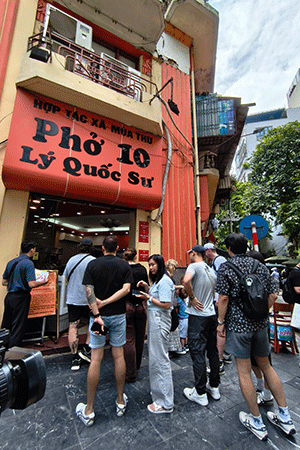 |
Visitors queue up at a café to buy a bowl of pho.
|
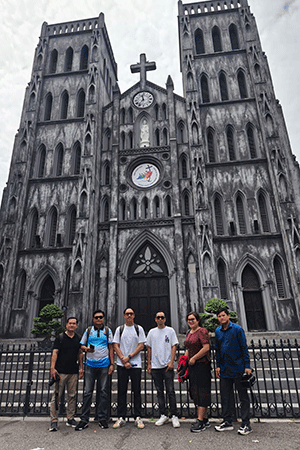 |
The Lao group poses for a photo outside St. Joseph’s Cathedral.
|
Beyond its food, Hanoi opened up doors to its culture and history. At St. Joseph’s Cathedral, a striking landmark in the heart of the city, we sat outside enjoying lime tea, which was cold, sweet, a little sour, and perfect for the warm afternoon.
At the Ho Chi Minh Mausoleum, we reflected on the life of Vietnam’s most revered leader. For many of us who had learned about him in Lao classrooms, standing at the site made history feel vivid and real. The Temple of Literature, one of the country’s oldest institutions, offered another glimpse into Vietnam’s traditions of education and architecture.
Dong Xuan Market, Hanoi’s largest, was buzzing with life. Stalls overflowed with fresh herbs, colourful fabrics, dried snacks, and even chocolate and nuts. Wandering through its busy alleys was both overwhelming and fascinating.
Our journey also took us to Bach Dang Giang in Haiphong province, a historical complex that commemorates Vietnam’s victories against foreign invaders.
With its towering statues, temples, and monuments, the site reflects the nation’s resilience and pride. For us as Lao journalists, it offered a deeper understanding of Vietnam’s past and its dedication to preserving heritage for future generations.
The five-day programme was more than a cultural tour. It enabled Lao and Vietnamese journalists to share ideas on how reporters can promote tourism and development, while also strengthening the bonds between our two countries.
When I returned home, what stayed with me was not only the taste of pho and the crunch of spring rolls, but also the warmth of the people and the depth of history I experienced.
Vietnam, with its rich blend of heritage and cuisine, is truly a place where history, culture, and food come together to create lasting memories.
By Souksamai Boulom
(Latest Update October 14, 2025)
|






